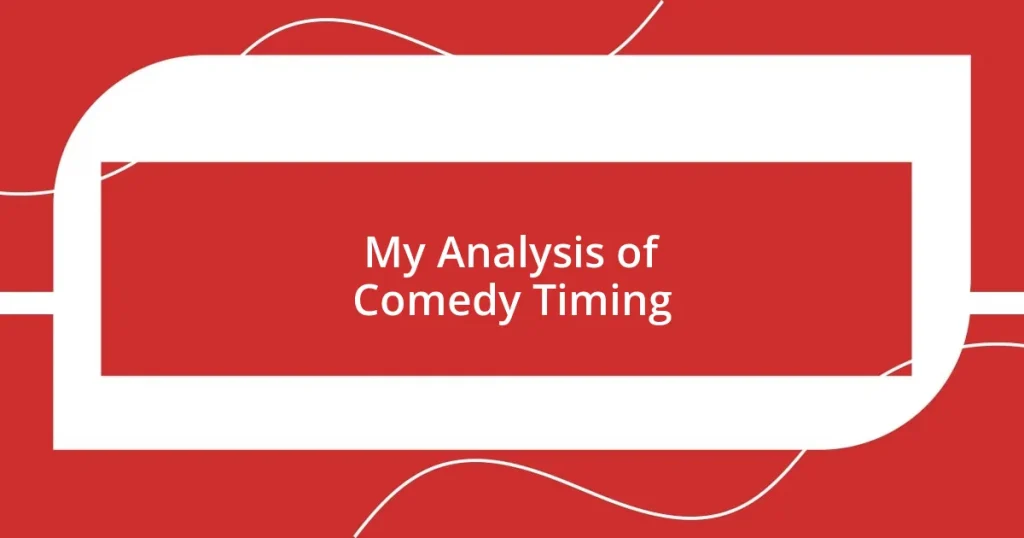Key takeaways:
- Effective comedy timing enhances punchline delivery by building anticipation and engaging the audience’s emotions.
- Key elements influencing timing include rhythm of delivery, audience energy, and physicality; each contributes to the overall impact of humor.
- Techniques like strategic pauses and the element of surprise can transform ordinary jokes into memorable experiences.
- Self-evaluation, reflection on performances, and peer feedback are essential for improving timing skills in comedy.
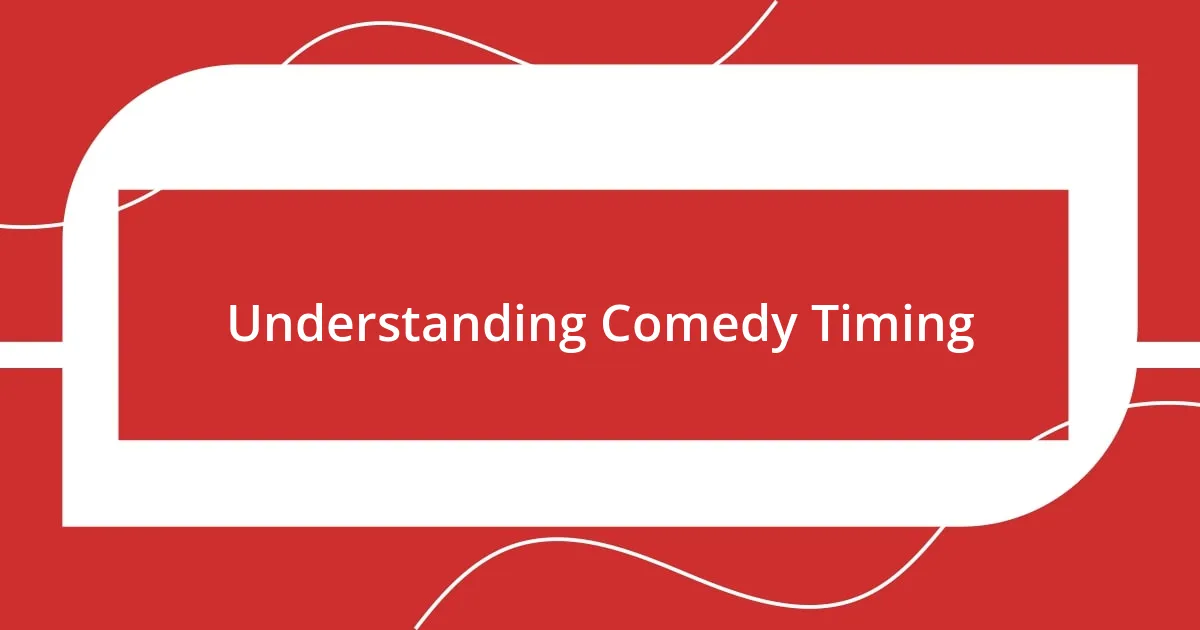
Understanding Comedy Timing
Comedy timing is all about knowing when to deliver a punchline for maximum effect. I remember the first time I bombed a joke at an open mic night; I rushed the setup and the punchline landed flat. It made me realize that the pauses and pacing can build anticipation, turning a simple joke into something much funnier.
Think about your favorite comedians for a moment; don’t they often pause right before the punchline, allowing tension to hang in the air? This isn’t just a gimmick; it’s a crucial part of their routine. During my own performances, I’ve noticed how a brief silence can electrify the room, making everyone lean in just before the big reveal.
Timing can also depend on the context, such as the audience’s mood or even the situation they’re in. I once performed at a charity event where the audience had just come from a somber moment. Adjusting my timing meant choosing my words carefully and delivering them slow enough to gradually ease the crowd into laughter without feeling inappropriate. Isn’t it fascinating how timing can transform a joke from potentially offensive to expertly humorous?
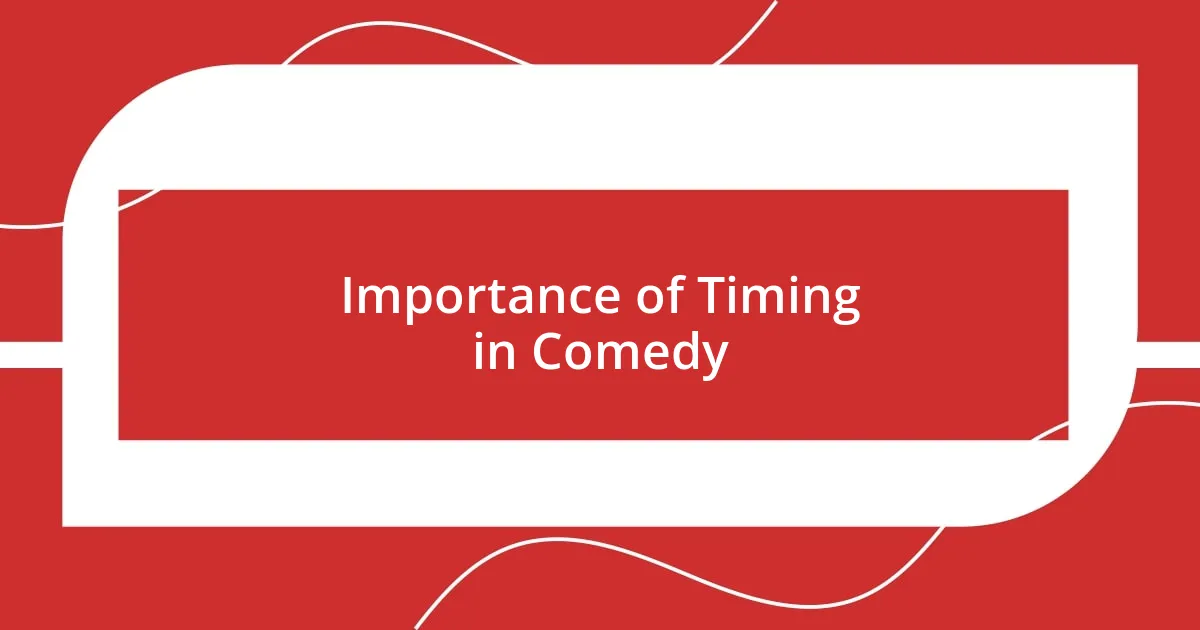
Importance of Timing in Comedy
Timing in comedy is like the heartbeat of a performance. When I think back to a particular show that went remarkably well, I remember the audience’s laughter came in waves — it wasn’t just me; it was the rhythm I created. I intentionally played with tempo, drawing out my words just a bit longer before hitting the punchline. That moment of anticipation had everyone on the edge of their seats, and it felt magical to watch their eyes light up when I finally delivered the joke.
Here’s why timing is essential in comedy:
- Builds Anticipation: A well-placed pause creates suspense, enhancing the punchline’s impact.
- Sets the Mood: Adjusting delivery speed can match audience emotions; it’s crucial to gauge reactions.
- Enhances Recall: Memorable punchlines often come from a clever use of timing, making jokes stick in listeners’ minds.
- Improves Engagement: The right timing keeps the audience involved, allowing them to follow the humor seamlessly.
Reflecting on my journey, I recall an experience where rushing a setup led to an awkward silence instead of laughter. It struck me how one miscalculated moment could throw off a whole routine. As I continue to learn and adapt, I cherish those lessons, allowing me to properly appreciate the nuanced dance that timing brings to each performance.
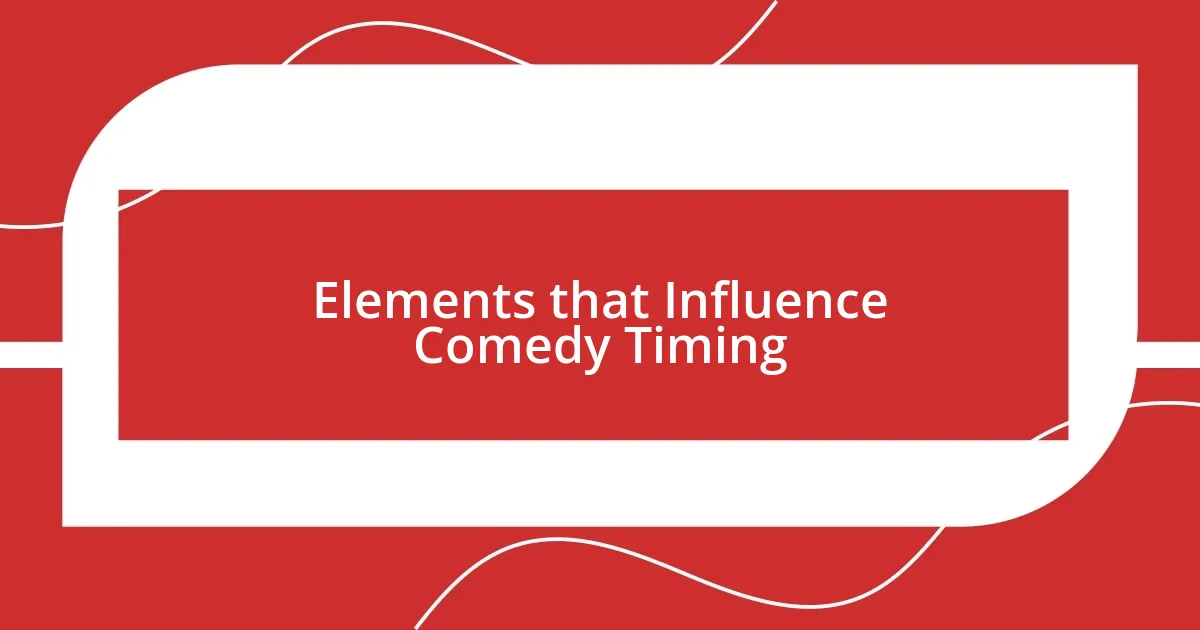
Elements that Influence Comedy Timing
Timing in comedy is influenced by several key elements, each playing a unique role in how humor resonates with the audience. One significant factor is the rhythm of delivery. I once saw a comedian who mastered this element; their performance felt like a song, with laughter that followed the beats. When the rhythm flows smoothly, it enhances the overall experience, enabling jokes to hit harder and connect more deeply.
Another crucial element is the audience’s energy. I’ve had nights where the crowd was exuberant, and I could ride that wave of enthusiasm, speeding up my delivery to match their excitement. Conversely, there have been times where the audience was more reserved, prompting me to slow down and thoughtfully pace my jokes, allowing laughter to build naturally. It’s amazing how these subtle shifts can change the atmosphere in the room entirely, transforming a flat performance into an engaging showcase of humor.
Finally, physicality and facial expressions significantly influence comedy timing. I remember a moment when I exaggerated a facial expression right before delivering a punchline, and the room erupted in laughter before I even spoke. That visual cue enhanced the anticipation, reinforcing the humor. This connection between physical presence and timing showcases the intricate layers of performance that impact how comedy is received.
| Element | Description |
|---|---|
| Rhythm of Delivery | How the pacing and flow of jokes create a musical quality, enhancing laughter. |
| Audience Energy | The responsiveness and mood of the audience, which can dictate the comedian’s timing. |
| Physicality | The use of body language and expressions to complement timing and amplify humor. |
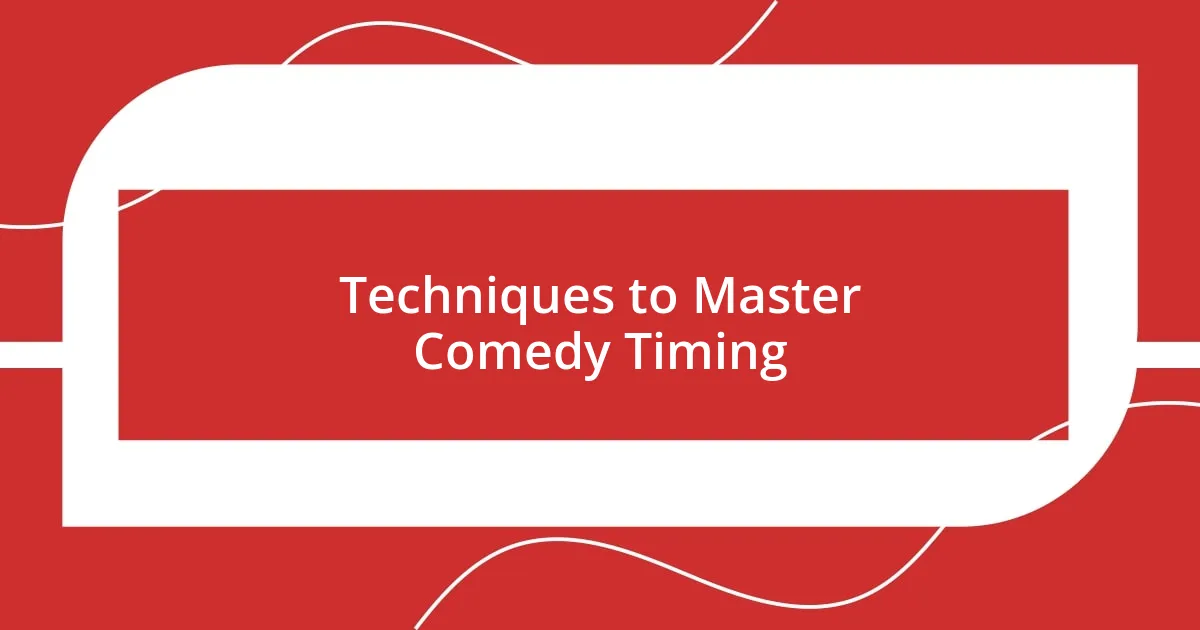
Techniques to Master Comedy Timing
When it comes to mastering comedy timing, one technique that stands out is the art of strategic pauses. I vividly recall a time at an open mic when I deliberately paused after stating a particularly absurd scenario. The waiting felt electric; I could almost hear the gears turning in the audience’s minds. That little moment of silence transformed mere words into a palpable anticipation, and when I finally delivered the punchline, the laughter erupted like popcorn popping. Have you ever experienced an unexpected silence that suddenly felt full of potential? That’s the magic of timing.
Another approach I’ve found effective is the element of surprise within my delivery. I once told a story that led listeners down a winding path before completely shifting the narrative at the last moment. The unexpected twist caught everyone off guard, and their laughter became a delightful fusion of shock and amusement. This technique underscores how vital it is not just to lead your audience but to occasionally take them on detours that heighten the overall experience. Have you ever been pulled in a direction you didn’t expect, only to find it utterly hilarious? That’s the blend of surprise and timing that makes a joke not just funny but memorable.
Finally, adapting your timing to the specific environment can’t be overstated. I remember performing at a venue where the seating arrangement created a cozy, intimate feel. Sensing the warmth in the room, I adjusted my pacing to be more conversational, almost like we were sharing inside jokes. This connection allowed me to weave laughter into the atmosphere effortlessly. It’s fascinating how a slight tweak in timing, informed by the audience’s vibe, can transform a routine. What’s your experience—have you ever changed your approach based on the vibe of the room? That’s where real comedy magic happens.
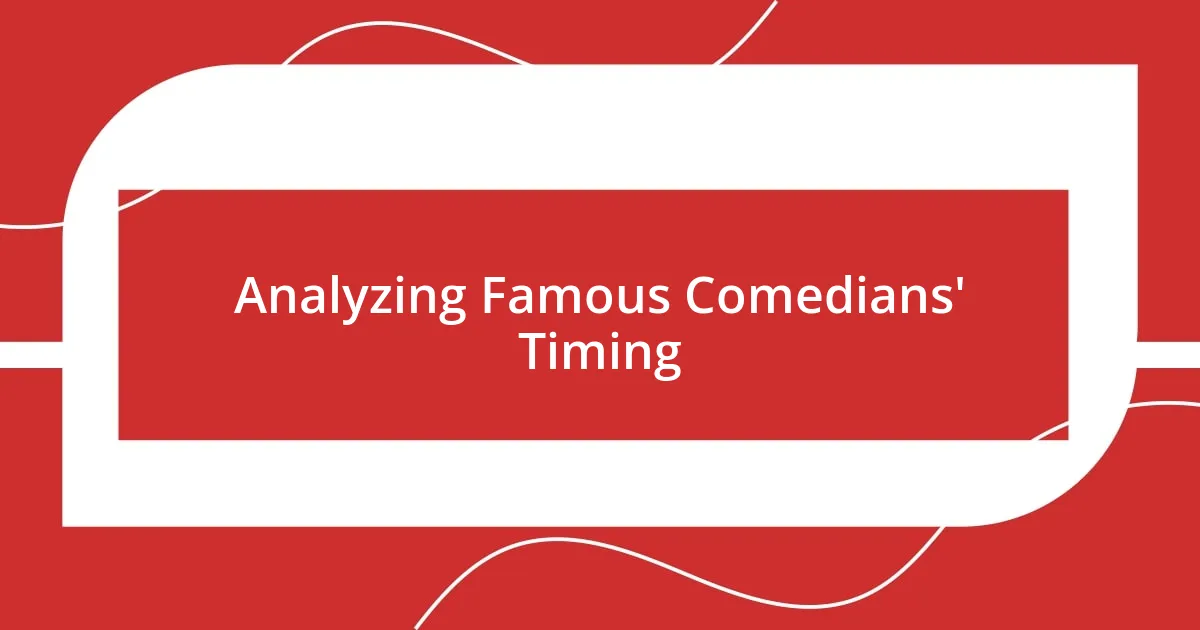
Analyzing Famous Comedians’ Timing
Watching famous comedians dissect their timing feels like learning a secret language. Take Jerry Seinfeld, for instance—his comedic rhythm is so precise that it often feels like he’s guiding the audience’s laughter. I remember a particular special where he paused seamlessly after a punchline, allowing the room to bubble with laughter before moving on. It’s those moments when he becomes one with the audience that truly capture the essence of timing in comedy.
Then there’s the unique style of comedians like Ellen DeGeneres. Her ability to weave personal anecdotes into her jokes creates an inviting atmosphere. I’ve seen her utilize timing to build a connection with the audience; she often leaves space for laughter after revealing something deeply relatable. Have you ever felt like a performer was sharing an inside joke just with you? That’s the magic of her timing—it evokes genuine emotions, making the jokes land even harder.
Another comedian that stands out in the realm of timing is Kevin Hart. His energy and rapid delivery sometimes give the impression that he’s racing to the punchline. Yet, what I admire most is his mastery of pacing—he knows when to slow down, letting the audience savor each laugh. I recall a moment from one of his specials where he rapidly shared an escalating series of misfortunes, pausing just long enough for us to catch our breath before another wave of laughter hit. It’s this delicate balance of speed and timing that keeps us on the edge of our seats, and it leads me to ask—how do you think timing shapes our anticipation in comedy?
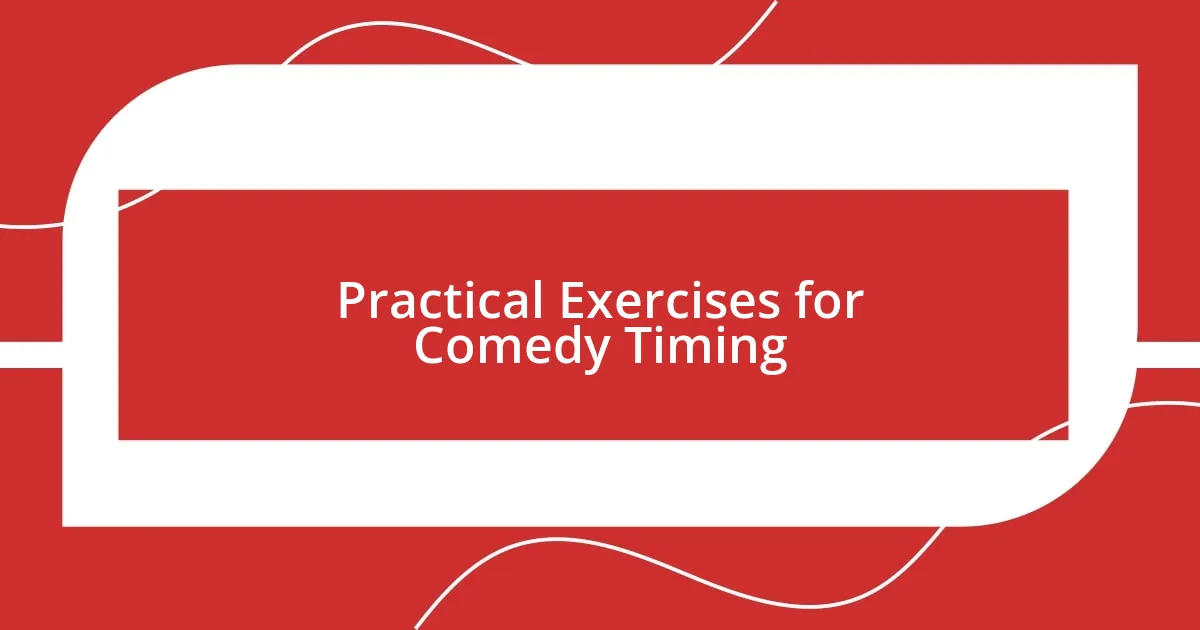
Practical Exercises for Comedy Timing
Practicing timing can be as simple as incorporating laughter cues into everyday conversations. I often try out small jokes with friends, adjusting my delivery based on their reactions. If I notice a slight chuckle, I pause just a moment longer to let the anticipation build before I deliver a punchline. It’s a fun and low-stakes way to experiment with timing while developing a more natural feel for how laughter flows within a conversation. Have you ever noticed how the rhythm of a good friend’s story can enhance the humor of a joke? That’s the kind of connection I seek to replicate.
Another effective exercise involves reading comedic scripts aloud. I remember picking up a well-known sitcom script and performing it, focusing on inflection and pacing. This exercise allowed me to internalize the unscripted pauses, the deliberate overlaps, and the sudden shifts in tone. For instance, when I read a character’s sarcastic remark, emphasizing the moment before the punchline turned it from a simple line to an engaging interaction. Isn’t it fascinating how bringing text to life changes its impact? This practice reminded me of the many layers performance can add to written material.
Finally, I find improvisation games invaluable. Participating in activities where you must react quickly helps sharpen my timing instincts. Once during an improv session, I was prompted to respond to a question with the most ridiculous answer while ensuring the punchline hit at just the right moment. The immediate laughter from my peers taught me how crucial timing is in creating a relatable and humorous atmosphere. Have you ever tried improv? The thrill of trust and spontaneity creates a unique space to explore timing in genuine, unfiltered ways.
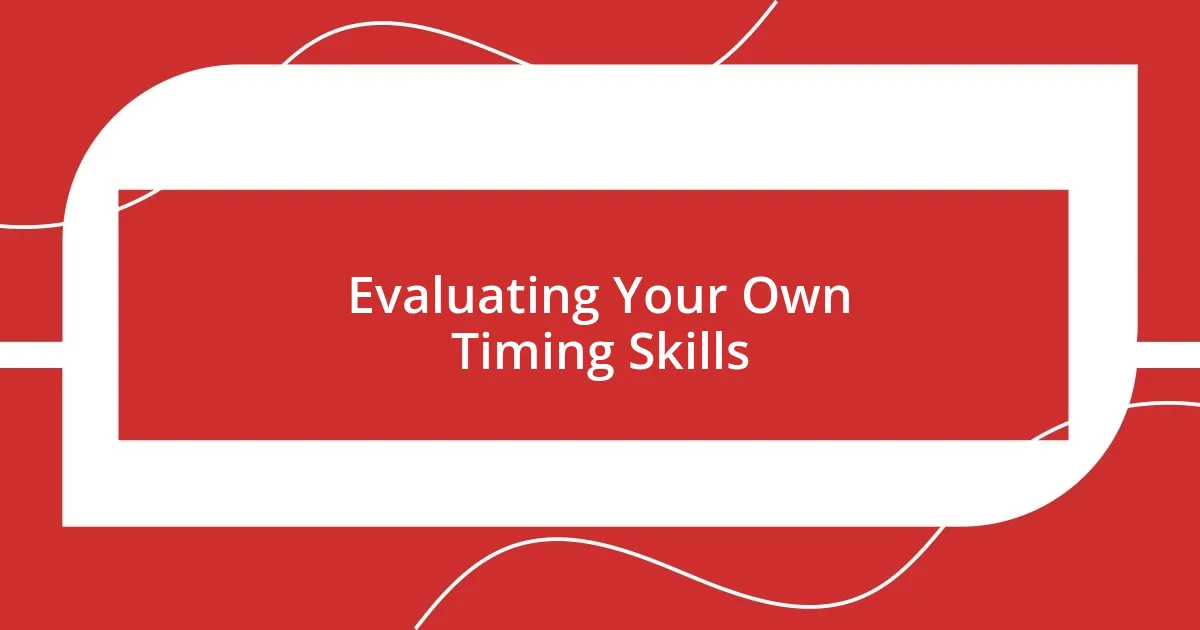
Evaluating Your Own Timing Skills
Evaluating your own timing skills can feel a bit like peeling back layers of an onion. Have you ever recorded yourself telling a joke? It’s eye-opening to see, in real-time, where the rhythms of your speech might fall flat or where a pause could amplify a punchline. I remember watching one of my own videos and feeling surprised at how quickly I rushed through certain jokes. Slowing down my delivery truly changed the way my audience reacted.
Another approach that has helped me is reflecting on live performances. After a show, I often think about which moments landed and which didn’t. I usually dissect those cringe-worthy pauses or misplaced laughs, asking myself how I could have created a better atmosphere. One night, I felt a joke truly bomb, and it wasn’t just the punchline—it was the timing. I realized I hadn’t allowed enough space for the audience to react. It taught me the significance of reading the room and adjusting on the fly.
Lastly, seeking feedback from friends or fellow comedians can provide invaluable insight. I encourage you to create a circle where everyone can openly discuss timing. I once sat down with a friend after a gig, and as we analyzed our performances, he pointed out moments where my timing could be refined. His observations opened my eyes to nuances I hadn’t considered before, making me wonder—how often do we overlook the value of collaborative growth in timing? Taking a step back and listening to others helped me cultivate a more nuanced understanding of my own style.










